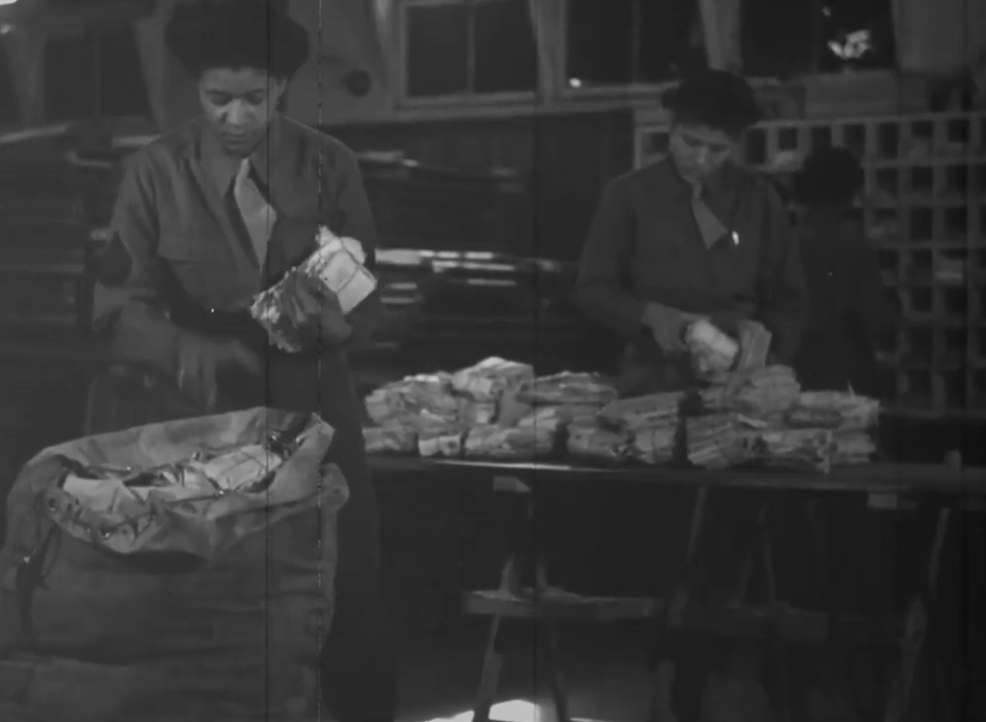African American Women in the Women’s Army Corps in in England
4/14/1945
Add to Favorites:
Add all page(s) of this document to activity:

This silent film shows the work of African American WACs (members of the Women’s Army Corps) sorting mail during World War II. When WWII started, many in America wanted to fight and serve, including many women. The Women’s Army Auxiliary Corps (WAAC) was created in May 1942 (it would later be named the Women’s Army Corps, or WAC), but the War Department announced that it would follow Army policy, and admit African American women with a 10-percent quota.
In addition to discrimination in civilian life, African American women faced segregation within the military. African American WAACs were in a separate company from white trainees, and had separate lodging, dining tables, and recreation areas. In July 1943, it was announced that the women of WAAC would be classified under the same ranks as soldiers, a big victory for women’s equality. The unit name changed to the Women’s Army Corps (WAC). African American WACs didn’t receive the same specialized training that white WACs had, however, and most were trained in motor equipment, cooking, or administrative work.
One of the biggest complaints amongst African American women in the Women’s Army Corps (WAC) was that there were no African American WACs overseas. The WAC had to abide by all Army regulations, and overseas commanders had the right to designate race or color of units being sent, and no African American WACs were requested. Eleanor Roosevelt intervened on their behalf, however, and the War Department directed commanders to accept African American WACs.
The 6888th Central Postal Directory Battalion was a unit of more than 800 African American WACs, and was the only African American WAC unit to serve overseas. They arrived in England in February of 1945, with the task of working through a huge backlog of mail meant for the troops. General Eisenhower wanted this mail to be delivered as a means of helping with the morale of the troops. When the WACs arrived, they found the building stacked to the ceiling with mailbags, and another room filled with packages of spoiled food and gifts, along with rodents.
Charity Adams, one of only two black WACs promoted to the rank of major during World War II, was the commander of this unit. She was proud of the work her unit did, performing their tasks in record time. Working in three shifts around the clock, they were able to sort all of the mail in half the amount of time expected, just 3 months. Each eight-hour shift averaged more than 65,000 pieces of mail sorted. Once finished in Birmingham, the unit went on to Rouen, France, and ultimately Paris.
In addition to discrimination in civilian life, African American women faced segregation within the military. African American WAACs were in a separate company from white trainees, and had separate lodging, dining tables, and recreation areas. In July 1943, it was announced that the women of WAAC would be classified under the same ranks as soldiers, a big victory for women’s equality. The unit name changed to the Women’s Army Corps (WAC). African American WACs didn’t receive the same specialized training that white WACs had, however, and most were trained in motor equipment, cooking, or administrative work.
One of the biggest complaints amongst African American women in the Women’s Army Corps (WAC) was that there were no African American WACs overseas. The WAC had to abide by all Army regulations, and overseas commanders had the right to designate race or color of units being sent, and no African American WACs were requested. Eleanor Roosevelt intervened on their behalf, however, and the War Department directed commanders to accept African American WACs.
The 6888th Central Postal Directory Battalion was a unit of more than 800 African American WACs, and was the only African American WAC unit to serve overseas. They arrived in England in February of 1945, with the task of working through a huge backlog of mail meant for the troops. General Eisenhower wanted this mail to be delivered as a means of helping with the morale of the troops. When the WACs arrived, they found the building stacked to the ceiling with mailbags, and another room filled with packages of spoiled food and gifts, along with rodents.
Charity Adams, one of only two black WACs promoted to the rank of major during World War II, was the commander of this unit. She was proud of the work her unit did, performing their tasks in record time. Working in three shifts around the clock, they were able to sort all of the mail in half the amount of time expected, just 3 months. Each eight-hour shift averaged more than 65,000 pieces of mail sorted. Once finished in Birmingham, the unit went on to Rouen, France, and ultimately Paris.
This primary source comes from the Records of the Office of the Chief Signal Officer.
National Archives Identifier: 17800
Full Citation: Motion Picture 111-ADC-3998; Negro Personnel, Hull and Cambridge, England; 4/14/1945; Moving Images Relating to Military Activities, 1947 - 1964; Records of the Office of the Chief Signal Officer, Record Group 111; National Archives at College Park, College Park, MD. [Online Version, https://docsteach.org/documents/document/african-american-wacs-england, April 25, 2024]Rights: Copyright Not Evaluated Learn more on our privacy and legal page.



